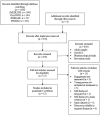Treatment Engagement in Specific Psychological Treatment vs. Treatment as Usual for Adolescents With Self-Harm: Systematic Review and Meta-Analysis
- PMID: 30778310
- PMCID: PMC6369209
- DOI: 10.3389/fpsyg.2019.00104
Treatment Engagement in Specific Psychological Treatment vs. Treatment as Usual for Adolescents With Self-Harm: Systematic Review and Meta-Analysis
Abstract
Background: Self-harm is a major public health problem. It is one of the best predictors of suicide in adolescents. Despite recent advances in the understanding of self-harm, poor treatment engagement remains a significant clinical obstacle. Objectives: The purpose of this meta-analysis is to update and extend previous research investigating treatment engagement with specific psychological treatments (SPT) vs. treatment as usual (TAU) in adolescents who self-harm. Methods: Data sources were identified by searching the Medline, PsychINFO, EMBASE, and PubMed databases as of October 2017. Randomized Controlled Trials (RCTs) comparing SPT and TAU in adolescents (through age 18 years) with self-harm were included. Results: The results show that 12 RCTs investigating 1,255 young people were included in the meta-analysis. The proportion of adolescents not completing four or more sessions in SPT was significantly lower (28.4%, 179/630) than TAU (45.9%, 287/625), RR = 0.64 (95% CI:0.51 -0.79), p < 0.0001. There were significantly more adolescents engaged with SPT than TAU. Conclusions: Specific psychological treatments should be offered to adolescents with self-harm to maximize treatment engagement. Engaging adolescents with psychological treatment is necessary although not sufficient to achieve treatment goals.
Keywords: meta-analysis; psychotherapy; randomized controlled trials; self harm; self injurious behavior.
Figures




References
-
- Brent D. A., Greenhill L. L., Compton S., Emslie G., Wells K., Walkup J. T., et al. . (2009). The treatment of adolescent suicide attempters study (TASA): predictors of suicidal events in an open treatment trial. J. Am. Acad. Child Adolesc. Psychiatry 48, 987–996. 10.1097/CHI.0b013e3181b5dbe4 - DOI - PMC - PubMed
LinkOut - more resources
Full Text Sources

